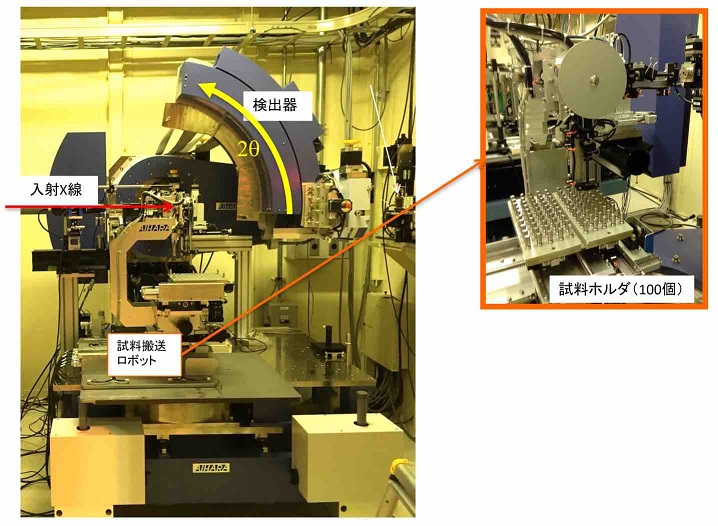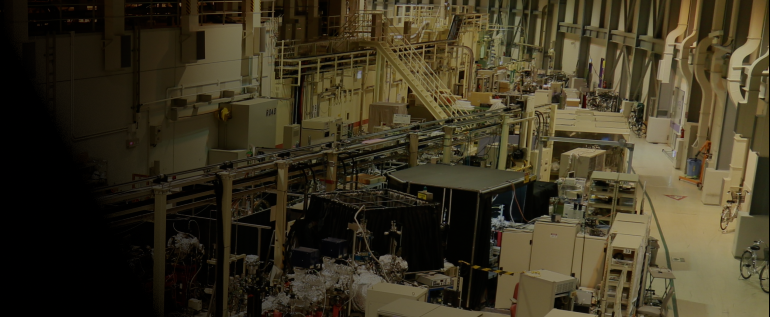ハイスループット粉末X線回折計
◆装置概要
多結晶など身近な材料の粉末回折測定ができます。数mgの微量の粉末試料があればデータが取れます。また、産業利用BLの特徴として、ロボットを用いた全自動測定が可能であり、さらにユーザが希望する様々な試料環境にも対応できる装置構成になっています。

◆装置の特徴
ハイスループット粉末回折装置はBL19B2の第1実験ハッチに設置されています。フォトンカウンティング型半導体1次元検出器MYTHENを回折角方向に12個並べたオリジナルの回折計です。1回の露光で回折角2θの80°の範囲を0.005°の角度分解能でカバーします。装置の制御には、コマンド入力型言語SPECに独自に開発したGUIを組み合わせたものを用いており、初心者でもすぐに実験方法を理解できるような仕組みにしています。試料交換や位置合わせなど、データ収集に関するほぼ全ての作業はロボットを利用して自動化されています。試料に照射するX線のビームサイズは縦0.3mm ×横3mmで,細いガラスキャピラリに粉末試料を充填して透過配置で測定します.利用可能なX線エネルギーは7-37 keVです.◆装置アクセサリー
ガラスキャピラリに低温あるいは高温の窒素ガスを直接吹き付けることによって試料の温度を変化させながら測定することができます。
低温装置は100-500 K、高温装置は室温-1000 Kをカバーします。これらの温度変化装置は試料交換ロボットと連携しており試料の準備さえ済めば全自動で温度変化測定のデータが得られます。
その他に、粉体化することが難しい試料に関しては、3軸同時揺動の仕組みをもつ特殊な試料ステージを用意しています。これを用いることで金属バルク試料のように結晶粒が大きいが粉末にすることが難しい試料においても、そのままの形態で結晶構造解析が可能な粉末回折プロファイルを取得することができます。
また、透過配置で実験できない平板試料についても反射配置測定でも十分に高い角度分解能のデータを収集できるマルチソーラスリットシステムを用意しています。
このようにロボットを用いた全自動測定以外にも様々な用途に利用できるように設計されていますので詳しくはビームライン担当にお尋ねください。
◆実験・試料準備
実験に用いるガラスキャピラリは試料とともにX線が照射され、それ自身からの散乱もバックグラウンドとして観測されます。
目的に応じて材質やサイズを使い分ける必要があります。
まず材質については、できる限り肉薄でX線散乱を起こしにくい「リンデマンガラス」製を基本としてお勧めします。
しかし、リンデマンガラスは高温で軟化するので、概ね500℃以上の高温実験を行う際には「ボロシリケートガラス」「ソーダガラス」「石英ガラス」製を利用してください。
最も高温に対する耐性が高いのは石英ガラス製ですが、バックグラウンドの形状が複雑になるのが欠点ですので使い分けが重要です。
キャピラリの内径は0.3 mmが標準ですが、X線吸収の影響などを加味して多少の増減を検討します。
なお、実験作業のほとんどはロボット化されているので実験進捗は試料調製に律速します。
したがって、ガラスキャピラリに粉末を充填する調製作業はあらかじめ来所前に済ませておくことをお勧めします。また、温度変化測定において試料の酸化や変質が懸念される場合はキャピラリ中を不活性ガス置換して封止するなどの対策をしてください。
粉末充填作業や試料ホルダの取り扱い方法については以下のURL内の動画の前半部分を参考にしてください。
https://support.spring8.or.jp/powder/jukebox.html
◆実験手順・注意事項
ロボットを用いた全自動測定では、
まず、ガラスキャピラリに粉末が充填されている状態のものを装置専用の試料ホルダに取り付けます。
扱いやすい取り付け治具を用意しているので1個あたり1-2分で準備完了です。
試料ホルダは最大100個までロボットに搭載できます。
試料の選択や露光条件はMicrosoft Excelのシートに入力します。
統計精度の高い精密なデータを得る条件を算出するために1試料1〜数分のスクリーニング測定をお勧めします。
この結果を見て、行いたい解析に対して十分な統計精度のデータを得るための露光条件(露光時間)を検討します。
また,必要に応じてガラスキャピラリのみ(ブランク)のデータを測定しておくといいでしょう。
ガス吹付による温度変化測定を行う際には露光時間に加えてガスの温度変化ならびに試料の温度安定に要する時間も考慮しなければなりません。
温度変化を含む測定には点数や変化速度にも依りますが室温のみの測定の2〜数倍の時間を要します。
また、温度変化に関しては、過冷却や過熱が試料の状態に影響を与える場合には、オーバーシュートを起こさないような変化速度を設定します。
これらの装置の条件も,Microsoft Excelのシートに入力することで制御できます.
◆問い合わせ先
大坂 恵一 このメールアドレスはスパムボットから保護されています。閲覧するにはJavaScriptを有効にする必要があります。
◆代表的な論文リスト
“New perovskite-related structure family of oxide-ion conducting materials NdBaInO4”
K. Fujii, Y. Esaki, K. Omoto, M. Yashima, A. Hoshikawa, T. Ishigaki, and J. R. Hester
Chem. Mater., 26, 8, (2014) 2488–2491
DOI:10.1021/cm500776x
“Quantitative analysis of heavy elements and semi-quantitative evaluation of heavy mineral compositions of sediments in Japan for construction of a forensic soil database using synchrotron radiation X-ray analyses”
I. Nakai, S. Furuya, W. Bong, Y. Abe, K. Osaka, T. Matsumoto, M. Itou, A. Ohta and T. Ninomiya
X-ray spectrometry 43, (2014) 38-48
DOI : 10.1002/xrs.2496
"Effect of Annealing on Crystal and Local Structures of Doped Zirconia Using Experimental and Computational Methods"
T. Itoh, M. Mori, M. Inukai, H. Nitani, T. Yamamoto, T. Miyanaga, N. Igawa, N. Kitamura, N. Ishida, and Y. Idemoto
The Journal of Physical Chemistry C 119 (16), (2015) 8447-8458
DOI:10.1021/jp5117118
"Crystalline-Amorphous-Crystalline Transformation in a Highly Brilliant Luminescent System with Trigonal-Planar Gold(l) Centers"
K. Igawa, N. Yoshinari, M. Okumura, H. Ohtsu, M. Kawano and T. Konno
Scientific Reports 6, (2916) 26002
DOI:10.1038/srep26002
"Versatile High-Throughput Diffractometer for Industrial Use at BL19B2 in SPring-8"
K. Osaka, Y. Yokozawa, Y. Torizuka, Y. Yamada, M. Manota, N. Harada, Y. Chou, H. Sasaki, A. Bergamaschi, and Masugu Sato
AIP Conference Proceedings 2054, (2019) 050008
DOI : 10.1063/1.5084626
High-Throughput X-Ray Powder Diffractometer
◆Equipment overview
It is possible to obtain powder diffraction measurements of materials such as polycrystals. Data can be obtained with a small amount of trace mg powder samples. In addition, a feature of the industrial use BLs is a robot that is available to make fully automated measurements, and the device configurating is compatible with many sample environments desired by the user.

◆Features of the Equipment
A high-throughput powder diffractometer is installed in the BL19B2 beamline’s first experimental hatch. MYTHEN, an original photon counting, 1-dimensional semiconductor detector, is arranged in 12 pieces in the angle equal to the diffraction angle. One exposure covers a 2θ diffraction angle of a range of 80°, and a resolution angle of 0.005°. To control the device, an original GUI has been developed for the input language SPEC, and is straight forward to allow first-time users to immediately understand the experimental methods. Almost all data collection operations, such as sample exchanges and sample positioning, are automatically completed using robots. While the sample is being irradiated by the X-rays, the beam size has a length of 0.3mm and a width of 3mm, and through a thin, glass capillary, the powder samples can be measured. The available X-ray energy is 7-37keV.◆Equipment accessories
By spraying a glass capillary with low or high temperature Nitrogen gas, the temperature of the sample changes and can be measured while changing.
The low temperature devices cover 100 to 500K, and the high-temperature devices cover everything from room temperature to 1000K. The temperature change devices are linked with the sample exchange robot, and once the sample is prepared, the temperature change measurement data can be obtained fully automatically.
In addition, for samples that are difficult to powder, a special sample stage with a three-axis simultaneous shake mechanism is available. This can be used for difficult to powder samples, such as bulk metal samples with large crystal grains, to obtain powder diffraction profiles that can be used to analyze the crystal structure.
In addition, for reflection arrangement measurements on flat plate samples that cannot be tested with transmission arrangements, a multi-solar slit system can collect data with very high angular resolution.
This such robot is designed to be used for various purposes other than fully automated measurements. Please ask the person in charge of the beamline for more information.
◆Experiment / sample preparation
During the experiment, the glass capillary and the sample are both irradiated with X-rays, and the background scattering is observed.
It is necessary to use different materials and size depending on the objective of the experiment.
First, it is recommended that the material be made of “Lindeman Glass”, which is thin and limits X-ray scattering.
However, Lineman glass becomes soft at high temperatures so for experiments above 500℃, please use “borosilicate glass”, “soda glass” or “quartz glass”.
Quartz glass has the highest temperature resistance, but the disadvantage is that the shape of the background is complex, so its use should be contemplated carefully.
The standard inner diameter of the capillary is 0.3mm, but increases and decreases under the influence of X-ray absorption.
In addition, since most of the experiment is completed by a robot, the progress of sample preparation is done quickly.
Therefore, it is recommended that the preparation work for filling the glass capillaries with powder be completed before coming to the office. Consequently, it is recommended that the preparation work of filling the glass capillary with powder be completed before entering the office. Also, if there is a concern about sample oxidation or deterioration while taking temperature change measurements, the capillary should be filled with inert gas or sealed.
For information on powder filling and operation of the sample holder, please refer to the first half of the video in the URL below.
https://support.spring8.or.jp/powder/jukebox.html
◆Experimental procedure / precautions
With fully automated measurements using the robot, first fill the capillary with powder, then attach to the sample holder dedicated to the device.
Easy-to-handle mounting jigs are available, which can each be assembled within 1-2 minutes.
Up to 100 sample holders can be mounted to a single robot.
Sample selection and exposure conditions are entered into a Microsoft Excel spreadsheet.
It is recommended that screening measurements of 1 minute per 1 sample is used to obtain high precision data with high statistical accuracy.
By looking at this result, you can determine the exposure conditions (exposure time) to obtain sufficient statistical accuracy for the data analysis you wish to perform.
Also, if necessary, glass capillary data (empty) should be measured.
When measuring temperature changes due to gas spraying, exposure time, the sample’s temperature stability and the time for the gas to change temperature should all be accounted for.
Temperature change measurements take at least 2 times longer than room temperature measurements, since they rely on several points to determine the rate of change.
In addition, for temperature changes, if overcooling or overheating affects the condition of the sample, it is possible to set a change rate so overshooting does not occur.
The conditions of these devices can also be controlled by entering them in a Microsoft Excel sheet.
◆Contact
大坂 恵一 このメールアドレスはスパムボットから保護されています。閲覧するにはJavaScriptを有効にする必要があります。
◆List of representative treatises
“New perovskite-related structure family of oxide-ion conducting materials NdBaInO4”
K. Fujii, Y. Esaki, K. Omoto, M. Yashima, A. Hoshikawa, T. Ishigaki, and J. R. Hester
Chem. Mater., 26, 8, (2014) 2488?2491
DOI:10.1021/cm500776x
“Quantitative analysis of heavy elements and semi-quantitative evaluation of heavy mineral compositions of sediments in Japan for construction of a forensic soil database using synchrotron radiation X-ray analyses”
I. Nakai, S. Furuya, W. Bong, Y. Abe, K. Osaka, T. Matsumoto, M. Itou, A. Ohta and T. Ninomiya
X-ray spectrometry 43, (2014) 38-48
DOI : 10.1002/xrs.2496
"Effect of Annealing on Crystal and Local Structures of Doped Zirconia Using Experimental and Computational Methods"
T. Itoh, M. Mori, M. Inukai, H. Nitani, T. Yamamoto, T. Miyanaga, N. Igawa, N. Kitamura, N. Ishida, and Y. Idemoto
The Journal of Physical Chemistry C 119 (16), (2015) 8447-8458
DOI:10.1021/jp5117118
"Crystalline-Amorphous-Crystalline Transformation in a Highly Brilliant Luminescent System with Trigonal-Planar Gold(l) Centers"
K. Igawa, N. Yoshinari, M. Okumura, H. Ohtsu, M. Kawano and T. Konno
Scientific Reports 6, (2916) 26002
DOI:10.1038/srep26002
"Versatile High-Throughput Diffractometer for Industrial Use at BL19B2 in SPring-8"
K. Osaka, Y. Yokozawa, Y. Torizuka, Y. Yamada, M. Manota, N. Harada, Y. Chou, H. Sasaki, A. Bergamaschi, and Masugu Sato
AIP Conference Proceedings 2054, (2019) 050008
DOI : 10.1063/1.5084626
